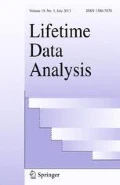Abstract
Interval-censored failure time data occur in many fields including epidemiological and medical studies as well as financial and sociological studies, and many authors have investigated their analysis (Sun, The statistical analysis of interval-censored failure time data, 2006; Zhang, Stat Modeling 9:321–343, 2009). In particular, a number of procedures have been developed for regression analysis of interval-censored data arising from the proportional hazards model (Finkelstein, Biometrics 42:845–854, 1986; Huang, Ann Stat 24:540–568, 1996; Pan, Biometrics 56:199–203, 2000). For most of these procedures, however, one drawback is that they involve estimation of both regression parameters and baseline cumulative hazard function. In this paper, we propose two simple estimation approaches that do not need estimation of the baseline cumulative hazard function. The asymptotic properties of the resulting estimates are given, and an extensive simulation study is conducted and indicates that they work well for practical situations.


Similar content being viewed by others
References
Andersen PK, Gill RD (1982) Cox’s regression model for counting processes: a large sample study. Ann Stat 10:1100–1120
Cox DR (1972) Regression model and life tables (with discussion). J R Stat Soc B 34:187–220
Cox DR (1975) Partial likelihood. Biometrika 62:269–276
Fan J, Lin H, Zhou Y (2006) Local partial-likelihood estimation for lifetime data. Ann Stat 34:290–325
Finkelstein DM (1986) A proportional hazards model for interval-censored failure time data. Biometrics 42:845–854
Goedert JJ, Kessler CM, Aledort LM, Biggar RJ, Andes WA, White GC 2nd, Drummond JE, Vaidya K, Mann DL, Eyster ME et al (1989) A prospective-study of human immunodeficiency virus type-1 infection and the development of AIDS in subjects with hemophilia. New England J Med 321:1141–1148
Hu XJ, Lawless JF (1996) Estimation from truncated lifetime data with supplementary information on covariates and censoring times. Biometrika 83:747–761
Huang J (1996) Efficient estimation for the proportional hazards model with interval censoring. Ann Stat 24:540–568
Huang J, Rossini AJ (1997) Sieve estimation for the proportional-odds failure time regression with interval censoring. J Am Stat Assoc 92:960–967
Kalbfleisch JD, Prentice RL (2002) The statistical analysis of failure time data. Wiley, New York
Klein JP, Moeschberger ML (2003) Survival analysis. Springer-Verlag, New York
Kroner BL, Rosenberg PS, Aledort LM, Alvord WG, Goedert JJ (1994) HIV-1 infection incidence among persons with hemophilia in the United States and Western Europe, 1978–1990. J Acquir Immune Defic Syndr 7:279–286
Logan BR, Zhang MJ, Klein JP (2011) Marginal models for clustered time-to-event data with competing risks using pseudovalues. Biometrics 67:1–7
Pan W (2000) A multiple imputation approach to Cox regression with interval-censored data. Biometrics 56:199–203
Pan W (2001) A multiple imputation approach to regression analysis for doubly censored data with application to AIDS studies. Biometrics 57:1245–1250
Peto R (1973) Experimental survival curves for interval-censored data. J R Stat Soc C 22:86–91
Sun J (1997) Regression analysis of interval-censored failure time data. Stat Med 17:497–504
Sun J (2006) The statistical analysis of interval-censored failure time data. Springer, New York
Zhang MJ, Klein JP (2001) Confidence bands for the difference of two survival curves under proportional hazards model. Lifetime Data Anal 7:243–254
Zhang Z (2009) Linear transformation models for interval-censored data: prediction of survival probability and model checking. Stat Model 9:321–343
Acknowledgments
The authors wish to thank the Chief Editor, Dr. Mei-Ling Lee, an Associate Editor and a referee for their many insightful and helpful comments and suggestions, which greatly improved the manuscript. This research is supported by NSFC with Grant No. 11201235.
Author information
Authors and Affiliations
Corresponding author
Appendix: Proofs of the asymptotic properties of \(\hat{\beta }_I\)
Appendix: Proofs of the asymptotic properties of \(\hat{\beta }_I\)
Proof of consistency of \(\hat{\beta }_I\) We first reparametrize the local partial likelihood \(l_I(\beta )\) via the transformation \(\xi =\beta -\beta _0,\) we just need prove that \(\hat{\xi }=\hat{\beta }-\beta _0\rightarrow 0\) in probability, the logarithm of the local partial likelihood function is
and define
Denote \(\bar{N}(t)=\sum _{i=1}^n N_i(t)\) and \(\bar{X}(t,\xi )=S_{n}^{(1)}(t,\xi +\beta _0)/S_{n}^{(0)}(t,\xi +\beta _0),\) clearly,
which is strictly negative semi-definite in probability. That is, \(\tilde{l}(\xi )-\tilde{l}(0)\) is concave in \(\xi \) with the unique maximizer \(\hat{\xi }.\)
Using a similar method used in proving Lemma A.1 in the paper of Fan et al. (2006), we can show that
where \(s_k(t,\beta _0+\xi )=E\{P_{\beta _0}(U\ge t|X)\exp ((\beta _0+\xi )'X)X^{\otimes k}\}.\) Combining the strong law of large numbers, it follows that \(M(\xi )\) converges almost surely to
A straightforward computation then yields
It can be easily seen that \(\left( \partial ^2\mathcal M ({ 0})/\partial \xi \partial \xi '\right) \) is strictly negative definite,and \(\left( \partial \mathcal M ( 0)/\partial \xi \right) =0.\) Hence, we obtain that \(\mathcal M (\xi )\) has maximum value at \(\xi =0.\) By the convexity of \(\tilde{l}(\xi )-\tilde{l}(0)\) and the concavity lemma, it follows that \(\hat{\xi }\rightarrow 0,\) the maximizer of \(\mathcal M (\xi )\) in probability.
This completes the proof.
Proof of the asymptotic normality of \(\hat{\beta }_I\) Start from the equality
We obtain that
where \(\Gamma _I(\beta _0)=E(\int _0^\infty \left( X -s_1(t)/s_0(t)\right) \text {d}N_1(t))^2,\) and which can be consistently estimated by
Since \(\hat{\beta }\) maximizes the log-likelihood function, and by the Taylor’s expansion, we have
where \(\gamma \) is between \(\hat{\beta }\) and \(\beta _0.\) Since \(\hat{\beta }\rightarrow \beta _0\) in probability, we have \( \ddot{l}_I(\gamma )\rightarrow \ddot{l}_I(\beta _0)\) and
We now need to prove that \(\ddot{l}_I(\beta _0)/n\) converges to an invertible matrix. Note that
where \(F_n(t)=\frac{1}{n}\sum \nolimits _{i=1}^nI(U_i\le t,\delta _i=1),\) and \(F_U(t)=P\{U\le t,\delta =1\}.\) It is easy to see that \(R_I(\beta _0)^{-1}\) is positive definite. Combining (2), (3) and (4), and by the Slutsky’s theorem we obtain that
This completes the proof.
Rights and permissions
About this article
Cite this article
Sun, J., Feng, Y. & Zhao, H. Simple estimation procedures for regression analysis of interval-censored failure time data under the proportional hazards model. Lifetime Data Anal 21, 138–155 (2015). https://doi.org/10.1007/s10985-013-9282-4
Received:
Accepted:
Published:
Issue Date:
DOI: https://doi.org/10.1007/s10985-013-9282-4



